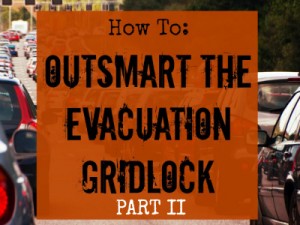 Bug Out Basics: Your Bug-Out Vehicle Checklist
Bug Out Basics: Your Bug-Out Vehicle Checklist
In my first “Outsmarting the Gridlock” post, I discussed the importance of building a comprehensive bug-out bag for each member of your family. Timing is crucial and there’s no time to pack.
But that article left out one critical piece of information: How will you actually get out of dodge? You’re not planning to hike out to that remote cabin in the woods are you?
For most of us, our bug-out location (whether it’s a family farm or a relative’s house) is simply beyond a reasonable walking distance, WAY outside…
More than likely, you’re going to be traveling by car. You family car, whether or not you realize it, is your “bug-out vehicle.”
Most Americans depend on their cars for everyday use, and their car/SUV/truck is so commonplace that they’ve never imagined truly depending on it in a survival situation…
Well, it’s time to give your vehicle a serious second look. If you intend to “bug-out” of an urban area, your success or failure may depend on your bug-out vehicle.
What Makes a Good Bug-Out Vehicle?
You’re probably expecting me to say “all-terrain tires,” or “four-wheel-drive” are the most important features of a good B.O.V.
Sure, those are nice-to-haves, but these are not anywhere near the top of your checklist. The most important aspect of a bug-out vehicle is dependability – plain and simple.
I don’t care if it’s a Honda Accord or an armored Humvee. If your car has shoddy tires, a history of overheating, or any other reliability issues… it’s immediately disqualified as a bug-out vehicle.
The chances that your car will have to withstand grinding traffic jams or dodge debris in the road are much greater that the chances that it will have to deflect RPGs or climb a mountain.
With that said, regular maintenance is crucial. Here’s a quick checklist of routine maintenance and necessary items that you should keep a running inventory of in your B.O.V.
- Extra motor oil
- Spare tire, lug wrench, jack
- Extra water/coolant
- Jumper cables
- Extra fuel (2-5 gallons)
- Tire repair kit
- Tire pump
- Hand tools (screwdrivers, ratchet set, etc.)
Tactical Considerations
If you have the time and resources, you might consider designating one of your daily drivers as your bug-out vehicle. That way, you can upgrade it as your survival budget allows.
This is when features like 4-wheel drive and all-terrain tires come into play.
Pickup trucks are natural bug-out vehicles, because of their storage capacity and higher ground clearance. SUVs offer more seating and better fuel economy in most cases. Even a sedan can be a perfectly good bug-out vehicle, as long as it has good tires.
Your survival vehicle can give you family far greater storage capacity than your bug-out bags alone. Sine weight isn’t as much of an issue, you can transport extra drinking water, food supplies, and larger firearms (rifles and shotguns) in your car.
Just to be clear these larger items and supplies are in addition to what’s in your bug-out bag. Like your bags, however, these items should also be packed and stored in a place where you access them easily and throw them in the car at a moment’s notice. It’s part of what I call your “5-Minute Crisis Inventory.” More on this in my next blog post.

